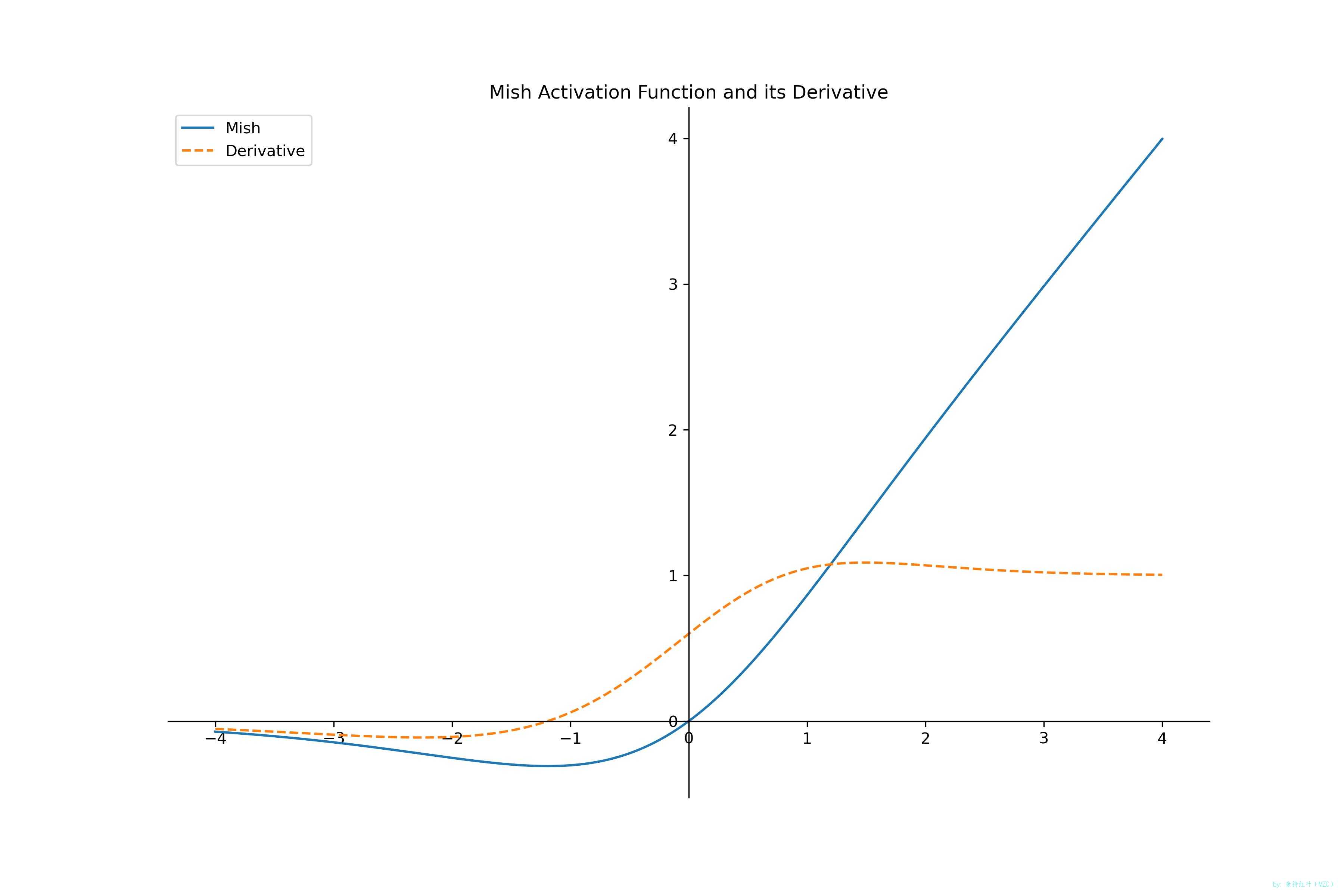文章目录
- Mish
- 函数+导函数
- 函数和导函数图像
- 优缺点
- PyTorch 中的 Mish 函数
- TensorFlow 中的 Mish 函数
Mish
-
论文
https://arxiv.org/pdf/1908.08681
函数+导函数
-
Mish函数
Mish(x)=x⋅tanh(softplus(x))=x⋅tanh(ln(1+ex))\begin{aligned} \text{Mish}(x) &= x \cdot \tanh\!\bigl(\text{softplus}(x)\bigr) \\ &= x \cdot \tanh\!\Bigl(\ln\!\bigl(1+e^{x}\bigr)\Bigr) \end{aligned} Mish(x)=x⋅tanh(softplus(x))=x⋅tanh(ln(1+ex)) -
Mish函数导数已知:
$$
\frac{d}{dx}\tanh(x) =1- \rm tanh ^2(x) \[2mm]\frac{d}{dx}\operatorname{Softplus}(x)=\sigma(x)=\frac{1}{1+e^{-x}}
$$
参考:神经网络常见激活函数 2-tanh函数(双曲正切)
则:
$$
\begin{aligned}
\frac{\mathrm{d}}{\mathrm{d}x}\text{Mish}(x)
&= x \cdot \tanh!\Bigl(\ln!\bigl(1+e^{x}\bigr)\Bigr)\&=\frac{\mathrm{d}}{\mathrm{d}x}x\cdot\tanh\bigl(\ln(1+e^{x})\bigr) + x \cdot \frac{\mathrm{d}}{\mathrm{d}x}\tanh\bigl(\ln(1+e^{x})\bigr) \[2mm]
&=\tanh\bigl(\ln(1+e^{x})\bigr) + x \cdot\bigl(1-\tanh2(\ln(1+e{x})\bigr)\cdot\frac{1}{1+e^{-x}}\
&=\tanh\bigl(\ln(1+e^{x})\bigr) + x \cdot\bigl(1-\tanh2(\ln(1+e{x})\bigr)\cdot\sigma(x)
\end{aligned}
$$
函数和导函数图像
-
画图
import numpy as np from matplotlib import pyplot as pltdef mish(x):"""Mish(x) = x * tanh(softplus(x))"""sp = np.log(1 + np.exp(x)) # softplus(x)return x * np.tanh(sp)def mish_derivative(x):"""Mish'(x) = tanh(softplus(x)) + x * (1 - tanh²(softplus(x))) * sigmoid(x)"""sp = np.log(1 + np.exp(x)) # softplus(x)t = np.tanh(sp) # tanh(softplus(x))s = 1 / (1 + np.exp(-x)) # sigmoid(x)return t + x * (1 - t ** 2) * sx = np.linspace(-4, 4, 1000) y = mish(x) y1 = mish_derivative(x)plt.figure(figsize=(12, 8)) ax = plt.gca() plt.plot(x, y, label='Mish') plt.plot(x, y1, label='Derivative', linestyle='--') plt.title('Mish Activation Function and its Derivative')ax.spines['right'].set_color('none') ax.spines['top'].set_color('none') ax.xaxis.set_ticks_position('bottom') ax.spines['bottom'].set_position(('data', 0)) ax.yaxis.set_ticks_position('left') ax.spines['left'].set_position(('data', 0))plt.legend(loc='upper left') plt.savefig('./mish.jpg',dpi=300) plt.show()
优缺点
-
Mish 的优点
- 平滑无断点:Mish 函数在整个实数域内连续可导,有助于稳定的梯度流,缓解梯度消失问题。
- 非单调性:负半轴有一段“下凹再回升”的曲线,有助于梯度流动,提升网络的表达能力。
- 无上界正值:正值部分无饱和区,避免梯度消失,适合深层网络,有有下界(≈ −0.31)。
- 实验性能:在 ImageNet、COCO 等多个基准上,Mish 常优于 ReLU、Swish 等激活函数。(并非绝对)
-
Mish 的缺点
- 计算开销大:相比 ReLU,需要额外计算 softplus、tanh 与乘法,推理延迟略高。
- 显存占用:反向传播需缓存中间结果,显存开销高于 ReLU。
- 并非万能:在某些轻量级或实时任务中,性能提升可能无法抵消额外计算成本,需要实验验证。
PyTorch 中的 Mish 函数
-
代码
import torch import torch.nn.functional as F# 固定随机种子 torch.manual_seed(1024) # CPU if torch.cuda.is_available():torch.cuda.manual_seed_all(42) # GPU,如果有x = torch.randn(2,dtype=torch.float32) mish_x = mish(x)print(f"x:\n{x}") print(f"mish_x:\n{mish_x}") """输出示例""" x: tensor([-1.4837, 0.2671]) mish_x: [-0.29912564 0.18258688]
TensorFlow 中的 Mish 函数
-
环境
python: 3.10.9
tensorflow: 2.19.0 -
代码
import tensorflow as tfdef mish(x):return x * tf.math.tanh(tf.math.softplus(x))# 生成随机张量 x = tf.constant([-1.4837, 0.2671], dtype=tf.float32) mish_x = mish(x)print(f"x:\n{x.numpy()}") print(f"mish_x:\n{mish_x.numpy()}")"""输出示例""" x: [-1.4837 0.2671] mish_x: [-0.29912373 0.18255362]







-day23)



)

)





)